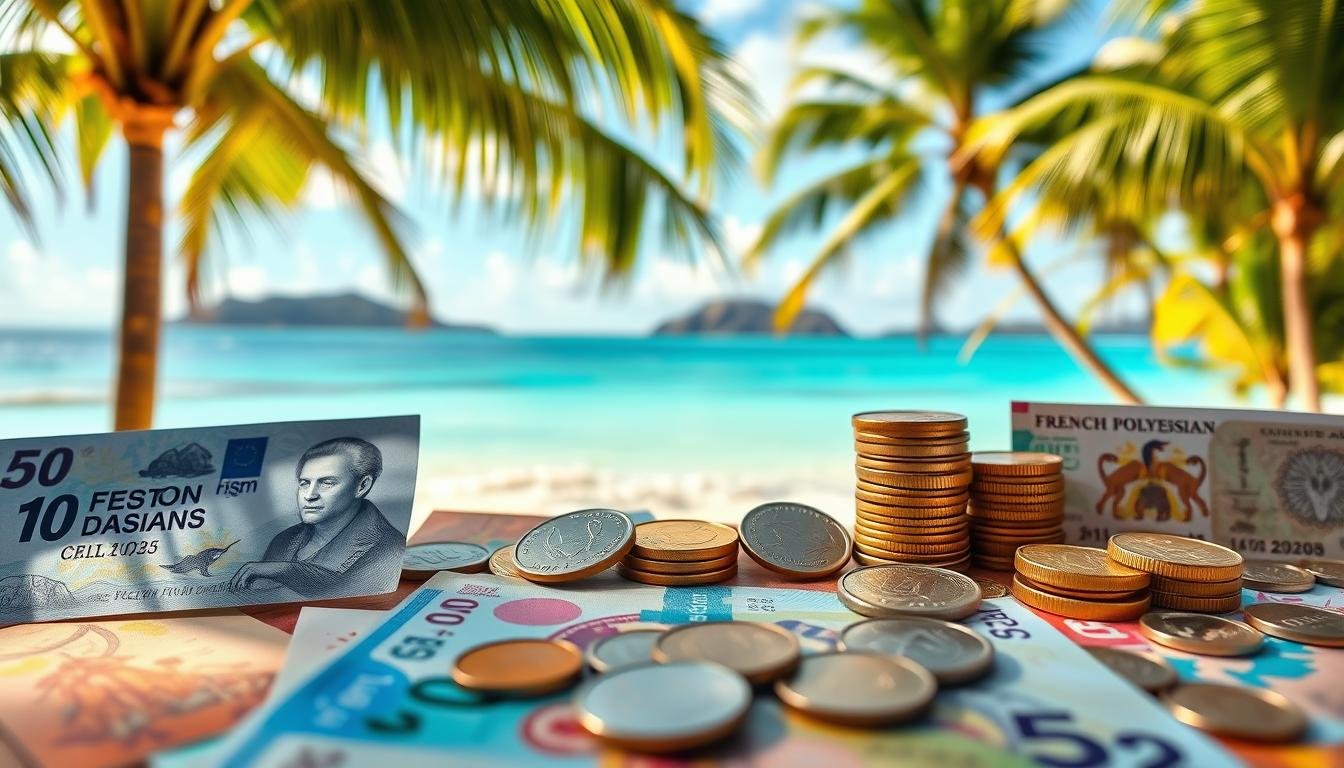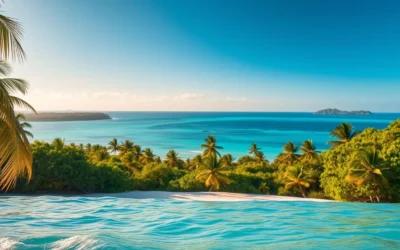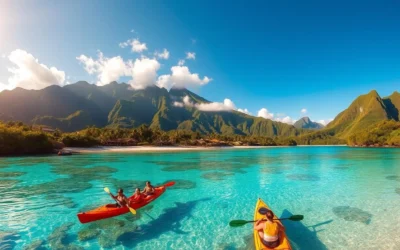✓ Accommodations✓ Flights✓ Rental Cars✓ Tours & Activities
Did you know that French Polynesia is made up of 118 islands, but only 67 are inhabited? This stunning destination is a dream for many, but managing your money and understanding the local currency can make or break your trip.
When you travel to this tropical paradise, knowing how to handle payments is essential. The official currency is the CFP franc, which is pegged to the euro. This means exchange rates are stable, but it’s still important to plan ahead.
Whether you’re dining at a local restaurant or booking a stay at a luxury resort, understanding the financial landscape ensures a smooth and stress-free experience. Let’s dive into everything you need to know to make the most of your trip.
Introduction to French Polynesia
Discover a world where crystal-clear lagoons meet vibrant culture. This stunning destination is made up of 118 islands, each offering unique experiences. From the iconic Tahiti to the breathtaking Bora Bora, every island has its own charm.
The region is famous for its pristine beaches and serene atolls. Whether you’re lounging on white sands or exploring coral reefs, the natural beauty is unmatched. The warm hospitality of the locals adds to the allure, making it a favorite for tourists worldwide.
Accommodations range from luxury hotels to cozy guesthouses. Overwater bungalows are a highlight, offering unparalleled views of the ocean. Many resorts blend modern comforts with traditional Polynesian designs, creating a unique stay.
Here’s a quick overview of what to expect:
| Feature | Details |
|---|---|
| Peak Season | May to October |
| Average Hotel Cost | $165 – $750 per night |
| Popular Activities | Snorkeling, cultural shows, lagoon tours |
With its mix of luxury and tradition, this destination promises an unforgettable experience. As you plan your trip, understanding the local culture and logistics will ensure a smooth journey.
French Polynesia: Ultimate Travelers Guide to Currencies & Payments
Stepping off the plane, you’ll immediately feel the warm embrace of island life. The first stop is usually Papeete Airport, where you can exchange your currency to the local CFP franc. Keep in mind that the exchange rate is fixed, but fees may apply. It’s a good idea to have some cash on hand for smaller purchases or transportation.
Most hotels and larger establishments accept major credit cards like Visa and Mastercard. However, smaller markets and local vendors often prefer cash. If you need to withdraw money, ATMs are available in Papeete and near major shops on other islands. Just note that some remote areas may have limited banking services.
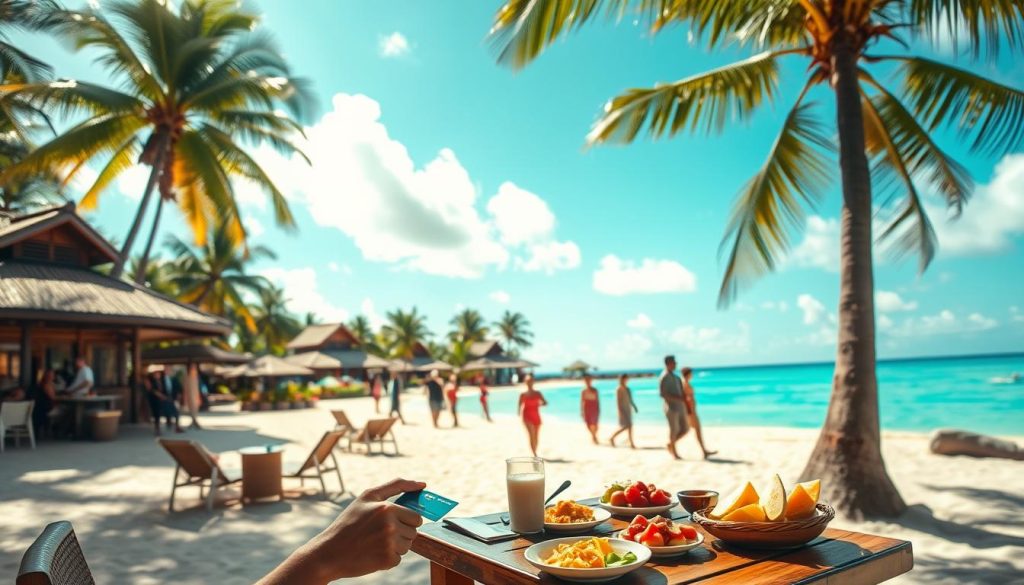
When it comes to banking, operating hours are typically from 8 AM to 3 PM, and they’re closed on weekends. Plan accordingly to avoid any inconvenience. Many banks don’t charge fees for card transactions, making it easier to manage your finances during your stay.
Overview of Island Diversity and Culture
As you explore, you’ll discover a rich blend of traditions and natural beauty. Each island has its own unique charm, from the bustling markets of Tahiti to the serene lagoons of Bora Bora. The locals are warm and welcoming, eager to share their culture with visitors.
Whether you’re enjoying a traditional dance performance or sampling local cuisine, the vibrant culture will leave a lasting impression. Don’t forget to carry some cash for smaller venues, as they may not accept cards. This way, you can fully immerse yourself in the island experience.
Understanding the CFP Franc and Local Currency
Understanding the CFP Franc can simplify your travel experience. This currency is the official tender in the region, and it’s essential to know how it works. The french pacific franc is available in both coins and banknotes, with denominations ranging from 1 to 10,000 XPF.
The exchange rate is fixed at 1 EUR = 119.33 XPF, making it stable and predictable. This means you can plan your budget without worrying about sudden fluctuations. However, it’s still a good idea to check the current rate before your trip.
CFP Franc Denominations and Exchange Rates
Coins come in 1, 2, 5, 10, 20, 50, and 100 XPF, while banknotes are available in 500, 1,000, 5,000, and 10,000 XPF. Smaller denominations are useful for everyday purchases like snacks or transportation. Larger notes are ideal for hotels or tours.
You can exchange your currency at airports, banks, or hotels. While airports are convenient, banks often offer better rates. Always compare fees to get the best deal.
Comparing CFP with USD, Euro, and AUD
The CFP Franc is pegged to the euro, but it’s helpful to know how it compares to other currencies. For example, 1 USD is approximately 110 XPF, while 1 AUD is around 75 XPF. These comparisons can help you budget effectively.
While some businesses accept dollar or euro payments, it’s not guaranteed. Carrying local currency ensures you’re prepared for any situation. ATMs are widely available in major towns, but remote areas may have limited access.
By understanding the french pacific franc and its exchange rates, you can manage your money with confidence. This knowledge will make your trip smoother and more enjoyable.
Using Credit and Debit Cards on Your Trip
Managing your finances while traveling is easier when you know where and how to use your cards. Credit and debit cards are widely accepted in tourist areas, making them a convenient option for payments. However, understanding the details can save you from unnecessary fees and hassles.
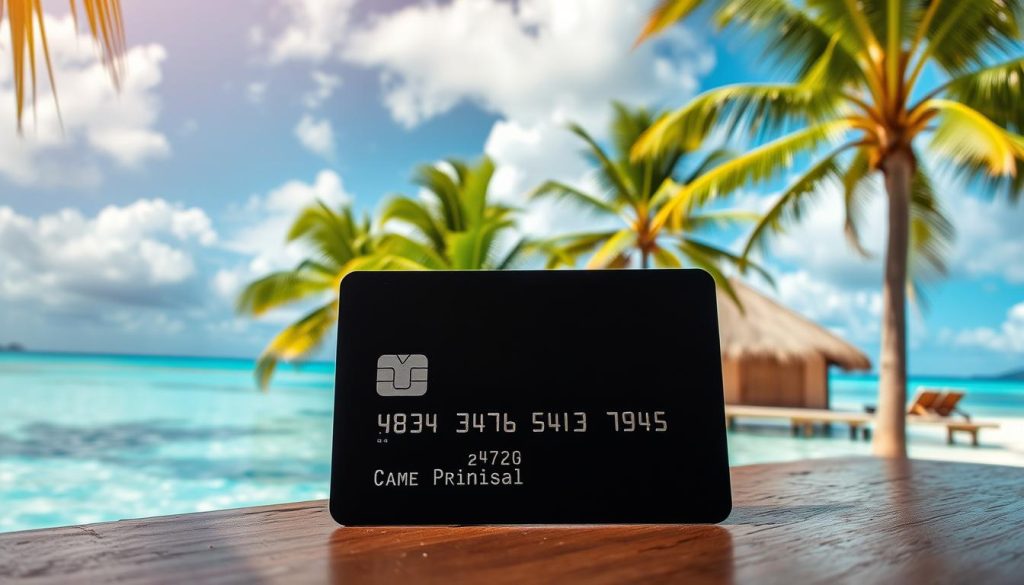
Where Cards Are Widely Accepted
Most luxury hotels, major restaurants, and retail outlets accept credit and debit cards. Visa and Mastercard are the most commonly supported, while American Express may have limited acceptance. Smaller vendors and local markets often prefer cash, so it’s good to carry both.
Here’s a quick overview of where you can use your cards:
| Location | Card Acceptance |
|---|---|
| Hotels | Widely Accepted |
| Restaurants | Major Establishments |
| Retail Stores | Common |
| Local Markets | Limited |
Avoiding Foreign Transaction Fees
Foreign transaction fees can add up quickly. To avoid them, check with your bank before your trip. Some banks offer cards with no international fees, which can save you money. Always choose to pay in the local currency to avoid extra charges.
Using a debit card for cash withdrawals at ATMs is another smart move. ATMs at major airports and towns provide access to local currency at competitive rates. Just be aware of any withdrawal fees your bank may charge.
By planning ahead and using your cards wisely, you can enjoy a seamless and cost-effective trip. Keep these tips in mind to make the most of your financial options while exploring the islands.
Planning Your Budget and Payment Options
Planning your budget is the first step to a stress-free adventure. Knowing how much to spend on accommodations, meals, and activities ensures you make the most of your trip. Start by listing your priorities, whether it’s luxury stays or exploring local markets.
When it comes to shopping, carrying a mix of cash and cards is ideal. Larger businesses and hotels accept credit cards, but smaller vendors often prefer cash. This balance lets you enjoy both upscale dining and authentic street food without hassle.
Time is precious, so plan ahead to save hours during your stay. Researching exchange rates and ATM locations beforehand ensures smooth transactions. Choosing the right place for payments, like banks for better rates, can also save you money.
Here’s a quick breakdown of expenses:
- Luxury stays: $200-$750 per night
- Local meals: $10-$30 per person
- Activities: $50-$150 per tour
By balancing your budget, you can enjoy the best of both worlds. Whether you’re shopping for souvenirs or dining at a high-end restaurant, smart planning ensures every dollar counts.
“A well-planned budget is the foundation of a memorable journey.”
Finally, always keep some cash for unexpected expenses. Remote areas may not have card facilities, so being prepared ensures you’re never caught off guard. With these tips, your trip will be as smooth as it is unforgettable.
Navigating ATM Withdrawals and Bank Services
Handling your money efficiently during your trip starts with knowing where to find ATMs and bank services. These resources are essential for accessing local currency and managing your finances smoothly. Whether you’re in a bustling tourist hub or a remote island, understanding the basics can save you time and money.
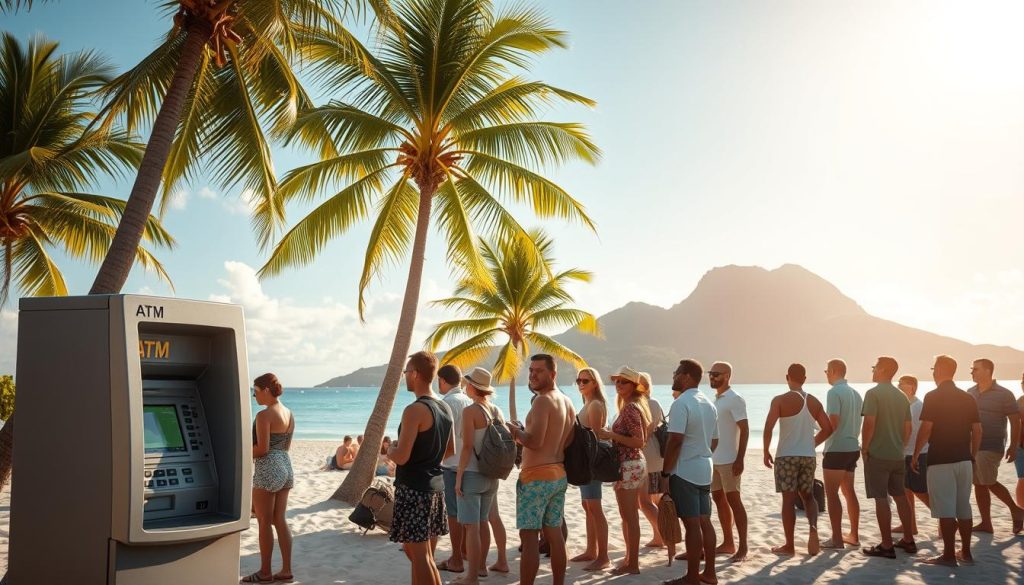
ATM Locations and Operating Hours
ATMs are widely accepted in major tourist areas like Papeete in Tahiti and Vaitape in Bora Bora. However, in remote islands, they can be scarce. It’s a good idea to withdraw cash before heading to less populated areas. Most ATMs operate 24/7, but some may have limited hours, especially in smaller towns.
Here’s a quick guide to ATM locations and their operating hours:
| Area | ATM Availability | Operating Hours |
|---|---|---|
| Papeete (Tahiti) | High | 24/7 |
| Vaitape (Bora Bora) | Moderate | 6 AM – 10 PM |
| Remote Islands | Low | Limited |
Understanding Denominations and Fees
When withdrawing cash, you’ll encounter different denominations of the local currency. Most ATMs dispense 500, 1,000, 5,000, and 10,000 XPF notes. Smaller denominations are useful for everyday expenses like snacks or transportation.
Be aware of fees. Independently-owned ATMs may charge up to ₣275 CFP Francs ($3.75 AUD) per transaction. Your bank might also add international withdrawal fees. To minimize costs, use ATMs from reliable companies like Banque de Tahiti or Banque Socredo.
Tips for Smart Withdrawals
Plan your withdrawals strategically. Exchange some money before your trip to avoid high ATM fees. When using ATMs, choose to withdraw in the local currency to avoid dynamic conversion charges. Always carry some cash for smaller vendors who may not accept cards.
By following these tips, you can navigate currency exchange and ATM withdrawals with confidence. This ensures you’re prepared for any financial situation during your adventure.
Tips for Managing Money on Your Island Adventure
Exploring the islands becomes smoother when you manage your money wisely. From dining at local restaurants to booking activities, having the right financial tools ensures a stress-free experience. Here’s how you can make the most of your adventure without breaking the bank.
Leveraging Travel Money Cards and Prepaid Options
Prepaid travel cards are a game-changer for managing your funds. They lock in favorable exchange rates and help you avoid hidden fees. Many cards also offer built-in travel insurance, adding an extra layer of security to your trip.
Here’s why prepaid options are worth considering:
- No foreign transaction fees.
- Easy to reload online or via an app.
- Accepted at most restaurants and shops.
Traditional credit and debit cards are still useful, especially for larger purchases. However, smaller vendors might prefer cash. Carrying a mix of both ensures you’re prepared for any situation.
When to Use Money Exchange Services
While money exchange services are convenient, they often come with higher fees. ATMs and banks usually offer better rates. If you need cash, withdraw in larger amounts to minimize transaction fees.
Here’s a quick tip: Always choose to pay in the local currency to avoid dynamic conversion charges. This simple step can save you money during your trip.
Managing Expenses at Local Businesses
Local markets and smaller restaurants often prefer cash. Having enough on hand for meals and souvenirs ensures you don’t miss out on authentic experiences. Don’t forget to budget for essentials like water, especially in remote areas where it might be scarce.
By using prepaid cards, planning your withdrawals, and carrying cash, you can navigate the unique financial environment of the polynesia french pacific with ease. These tips will help you focus on enjoying your adventure without worrying about your wallet.
Safety and Best Practices for Currency Exchange
Ensuring your money is safe during your vacation starts with smart exchange practices. Knowing where and how to exchange currency can save you time, money, and stress. This guide will help you navigate the process securely and efficiently.
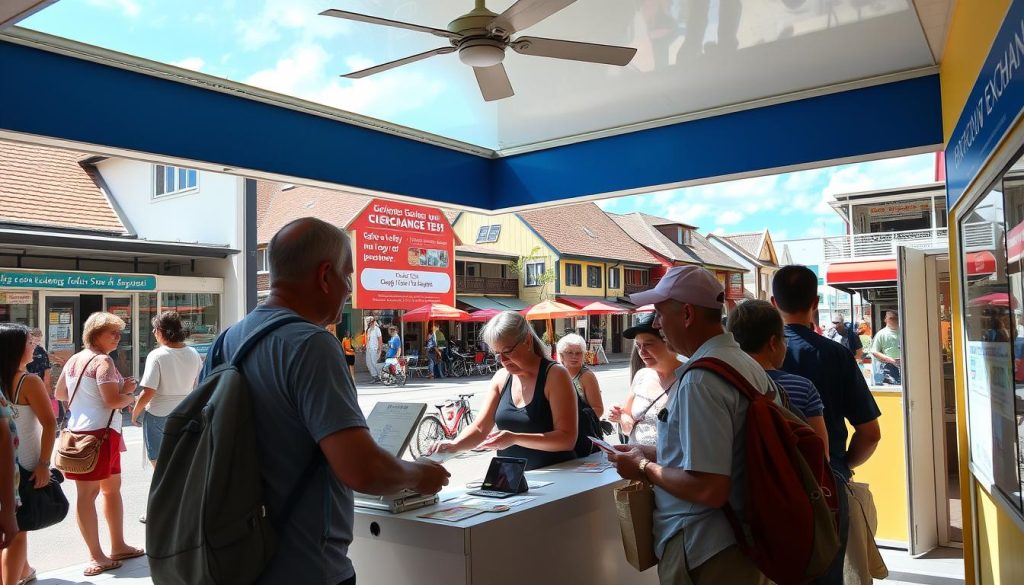
Exchange Locations at Airports and Banks
When exchanging money, always use trusted locations like banks or official exchange offices. Airports are convenient, but their rates may not be the best. Banks often offer more favorable rates and lower fees. Keep your money in hand until you’re confident in the transaction details.
Here’s a comparison of exchange options:
| Location | Pros | Cons |
|---|---|---|
| Airports | Convenient, available 24/7 | Higher fees, less favorable rates |
| Banks | Better rates, lower fees | Limited hours, may require ID |
| Official Offices | Reliable, honest rates | May have limited locations |
How to Avoid Unfavorable Rates
To avoid unfavorable rates, plan ahead and compare offers. Use official exchange offices or banks for the best deals. Always keep your money in hand until you’re satisfied with the rate. Monitoring transaction details ensures you’re not overcharged.
Here are some tips to save money:
- Check current rates online before exchanging.
- Avoid exchanging money at hotels or tourist spots.
- Carry a mix of cash and cards for flexibility.
By following these practices, you can enjoy your vacation without worrying about your finances. Safe and smart currency exchange ensures a smooth and stress-free trip.
Insights into Hospitality and Resort Payment Methods
High-end resorts in Bora Bora offer a seamless blend of comfort and convenience. From overwater villas to beachfront suites, these accommodations ensure a luxurious experience. Understanding the payment options available can make your stay even more enjoyable.
Payment Options at Luxury Hotels and Resorts
Most luxury resorts accept major credit cards like Visa and Mastercard. Some also offer digital payment methods for added convenience. Cash is less common but can be useful for smaller transactions or tips.
Here’s a quick overview of payment methods:
- Credit cards: Widely accepted for room charges and dining.
- Digital wallets: Available at select resorts for quick payments.
- Cash: Useful for tips or local purchases.
Tipping Guidelines and Local Customs
Tipping is not mandatory but appreciated in tourist areas. For exceptional service, a small tip is a kind way to show gratitude. Many resorts include service charges in the bill, so check before tipping.
Here are some tipping suggestions:
- Restaurants: 5-10% of the bill if service is exceptional.
- Housekeeping: $5-$10 per day for excellent service.
- Tour guides: $10-$20 per person for a memorable experience.
By understanding these practices, you can navigate payments and tipping with ease. This ensures a smooth and respectful experience during your stay.
Conclusion
Exploring the islands becomes smoother when you manage your money wisely. The french pacific monetary system, centered around the pacific franc, plays a key role in daily transactions. Being well-prepared with the right payment options ensures a stress-free experience.
Smart planning and informed choices can make your trip more enjoyable. From using travel cards to carrying cash for local markets, these tips help you navigate financial challenges with ease. Understanding the pacific franc and its exchange rates simplifies budgeting.
By applying these insights, you can focus on enjoying the beauty of the islands. Whether dining at local spots or booking activities, the right financial tools enhance your adventure. Make the most of your journey with these practical tips.
The above is subject to change.
Check back often to TRAVEL.COM for the latest travel tips and deals.
